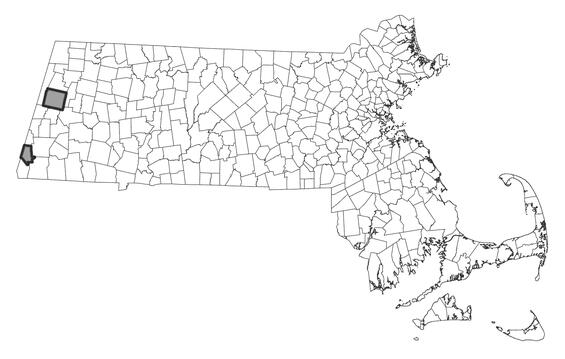- Scientific name: Rhynchospora capillacea
- Species of Greatest Conservation Need (MA State Wildlife Action Plan)
- Endangered (MA Endangered Species Act)
Description
The capillary beaksedge (Rhynchospora capillacea) is a small (1.5-5.0 dm; 6-20 in), perennial herb with threadlike stems and leaves. Although the capillary beaksedge and the other beaksedges do superficially resemble the group of plants called “rushes,” they do not belong to the rush family, and are actually members of the sedge family. The capillary beaksedge is quite delicate in appearance, due to its thread-like leaves, and may easily be overlooked. In Massachusetts, it generally grows in small, very wet openings (such as along deer-paths, edges of wet depressions or channels, or seepy areas) in calcareous fens. Elsewhere in New England, it is also found growing on calcareous riverside seeps and on dripping, calcareous cliffs.
To positively identify the capillary beaksedge and other beaksedges (genus Rhynchospora), a technical manual should be consulted. It is best to examine the tiny fruits and flower bristles of the plant under magnification to distinguish the species of beaksedge. The beaksedges in general possess clusters of very inconspicuous flowers. Rather than having petals, the individual flowers possess tiny “bristles.” Their fruit is an “achene,” which is hard and nut-like and does not split open to release its seeds. Achenes in the beaksedges are topped by a protuberance (called a “tubercle”), which varies in shape and size among species. In the capillary beaksedge, the achene is relatively elongate and narrowed gradually to the base. It is associated with six downwardly-barbed bristles, and is topped by a long, very gradually tapering tubercle, which looks like a dunce’s cap. The entire inflorescence is usually overtopped by a threadlike bract.
There are several common beaksedges that could be confused with the capillary beaksedge, and a technical manual should be consulted when trying to distinguish members of this genus. Two beaksedges that have repeatedly been reported to co-occur with R. capillacea in the field are white beaksedge (R. alba) in fens, and brown beak-sedge (R. capitellata) along river shores. Capillary beaksedge differs from the white bea-sedge in having fewer bristles per flower (six, as opposed to eight to fourteen in white beaksedge) that are not feathery at the base (plumose at the base in white beaksedge). To the naked eye, the capillary beaksedge has a narrower, ovoid cluster of flowers that is brownish, and the white beaksedge has a broader-tipped cluster of flowers that is white or tawny-colored. Capillary beaksedge differs from the brown beaksedge in having a narrower achene, with many fewer clusters of flowers. To the naked eye, the one or two clusters of flowers in R. capillacea are narrow and ellipse-shaped. In R. capitellata, there are usually several hemispheric clusters.
Life cycle and behavior
This is a perennial species.
Population status
The capillary beaksedge is listed under the Massachusetts Endangered Species Act as Endangered. All listed species are protected from killing, collecting, possession, or sale and from activities that would destroy habitat and thus directly or indirectly cause mortality or disrupt critical behaviors. MassWildlife’s Natural Heritage & Endangered Species Program database has 2 records from 1 county (Berkshire). Both records are from Berkshire County, and 1 of those is within the last 25-year period.

Distribution in Massachusetts
1999-2024
Based on records in the Natural Heritage Database
Distribution and abundance
The capillary beaksedge occurs from Newfoundland west to Saskatchewan, and south to Texas and Alabama.
Habitat
In Massachusetts, this shade-intolerant species is found growing in open, mucky areas of calcareous fens, which are nutrient-rich peatlands that have contact with local groundwater. Usually, the plants are found growing in low, open areas of micro-disturbance, such as along deer paths or seepage channels. Plants associated with capillary beaksedge in Massachusetts include shrubby cinquefoil (Dasiphora floribunda), fen-sedge (Carex tetanica), dioecious sedge (Carex sterilis), slender woolly-fruited Sedge (Carex lasiocarpa), grass-of-Parnassus (Parnassia glauca), yellow sedge (Carex flava), white beaksedge (Rhynchospora alba), tamarack (Larix laricina), and black spruce (Picea mariana).
Healthy habitats are vital for supporting native wildlife and plants. Explore habitats and learn about conservation and restoration in Massachusetts.
Threats
As for many rare species, exact needs for management of capillary beaksedge are not known. The following comments are based primarily on observations of populations in Massachusetts. Habitat conversion, alterations to local hydrology, and open wetland succession to forested wetland are the primary threats faced by this species.
Conservation
Management efforts should focus on maintaining local hydrology (including intact seepage areas) and maintaining open fen conditions with small areas of disturbance, such as those created by seeps and animal trails.
Contact
| Date published: | May 7, 2025 |
|---|